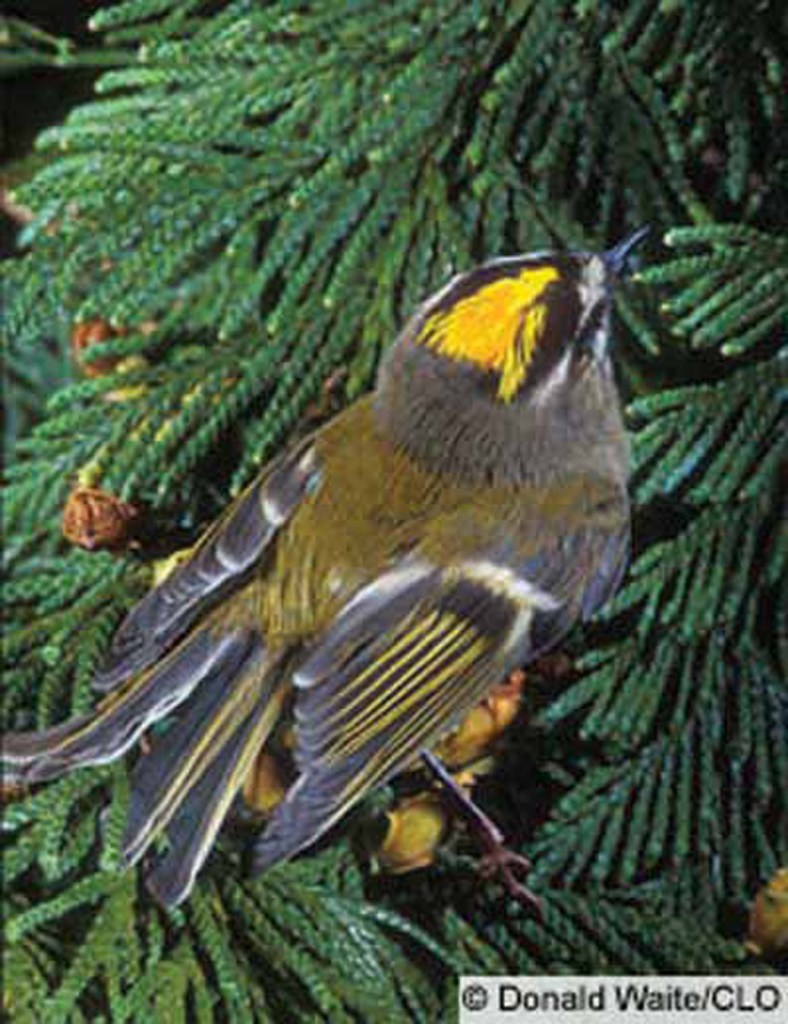Recently, I bought Bernd Heinrich’s ”Winter World” (Harper Perennial), a wonderful nature book by one of the world’s more prolific and entertaining naturalists.
Heinrich owns a cabin in Perkins Township west of Farmington, a getaway spot from his job as professor of biology at the University of Vermont. Here in Maine, Heinrich spends free time from the university with meticulous, scientific studies of our fauna and flora.
Golden-crowned kinglets (Regulus satrapa) flit around Heinrich’s woodland cabin, a species that came by its genus name honestly. ”Regulus” means ”little king,” a reference to its diminutive size and golden crown.
This kinglet has interested Heinrich since childhood, so in ”Winter World,” he devotes part of at least four chapters to this species. However, he mentions this bird here and there throughout the book.
Recently, while waiting in a doctor’s office on an unseasonably warm February morning, I started reading this book and finished two chapters devoted to this kinglet. As usual, though, I’m getting ahead of myself.
Let’s turn the calendar back to December, a late, snowy afternoon in the Kennebec Highlands northwest of Belgrade Lakes village. As flakes sifted to the ground, a golden-crowned kinglet had caught my attention in its usual way, calling from the upper canopy in an ancient, majestic stand of eastern hemlocks — among the oldest tree species in the Northeast.
Two thoughts always come to mind when sitting or hiking through this ancient conifer species and encountering this kinglet:
• Hemlock can live more than 600 years, so some Maine specimens germinated in Richard II’s reign — talk about antiquity.
• This kinglet measures 31/2 to 4 inches long, sports a 7-inch wingspan and weighs 0.21-ounce — about half the weight of a black-capped chickadee. This begs an obvious question: How does such an absolutely minuscule bird survive a Maine winter? Its ability to endure the season wows me.
This kinglet proves so predictable, too. Several Decembers ago, when participating in Audubon’s Christmas Bird Count, I’d walk into hemlock or spruce stands at least once in the day and have a reasonably good chance of hearing a golden crown to add the species to the bird list.
This kinglet makes a high, thin ”see-see-see” followed by a tumbling chatter. Last December in the Kennebec Highlands, a ridge sheltered the bird and me from a northwest wind’s raw bite and mellifluous, whooshing sound, so it was easy enough to hear the unmistakable call.
I was standing on a steep side hill so my eyes were nearly even with the top of a hemlock where this kinglet stayed in constant motion, pecking at branchlet ends while apparently foraging on what I thought was aphids, other tiny invertebrates and invertebrate larvae.
My assumption on its winter diet seemed sound, but this critter stays in constant motion and ranks as one of the world’s smallest birds. It requires a quicker eye than mine to see exactly what it was eating.
Heinrich conducted a wicked clever study on this kinglet’s winter forage and described it in ”Winter World.” This scientist obtained a permit to kill kinglets and in the first gizzard, found 39 geometrid (inchworm) caterpillars. Subsequent gizzards revealed a steady diet of more geometrids.
Before that, researchers had suspected geometrid caterpillars left cocoons that foraging kinglets consumed, but scientists hadn’t suspected kinglets ate caterpillars, crawling around in the dead of winter.
Heinrich’s study revealed a second intriguing fact: The first golden-crown specimen had a body temperature of an incredible 111 degrees Fahrenheit immediately after its demise.
After establishing the forage, Heinrich and his students later gathered these caterpillars, but not even an entomologist from the Smithsonian Entomology Laboratory could identify this particular geometrid.
Late winter creates a perfect time for reading ”Winter World” to unlock mysteries we encounter on hikes, a must read for Maine residents.
One last point:
New England spawned the transcendental movement in the 19th century, which is alive and well in this state. When sitting in rural restaurants, I often hear a version of this philosophy when folks say you can’t learn from a book. They claim experience is the best teacher.
Horsefeathers to that notion.
Woodland wanderers who feel folks can’t learn from a book have never read the good professor from Maine’s Perkins Township and the University of Vermont.
Ken Allen of Belgrade Lakes is a writer, editor and photographer. He can be contacted at: KAllyn800@aol.com
Send questions/comments to the editors.




Success. Please wait for the page to reload. If the page does not reload within 5 seconds, please refresh the page.
Enter your email and password to access comments.
Hi, to comment on stories you must . This profile is in addition to your subscription and website login.
Already have a commenting profile? .
Invalid username/password.
Please check your email to confirm and complete your registration.
Only subscribers are eligible to post comments. Please subscribe or login first for digital access. Here’s why.
Use the form below to reset your password. When you've submitted your account email, we will send an email with a reset code.